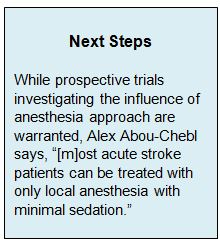Key Points:
- Single-center study looks at influence of anesthesia type during endovascular stroke therapy
- General anesthesia not a homogenous category
It is time to properly investigate how the approach to general anesthesia affects outcomes of endovascular management of acute ischemic stroke, according to a paper published online November 27, 2015, ahead of print in the Journal of Neurointerventional Surgery. The single-center review suggests that volatile anesthesia may be the best choice.
According to the 2015 update to the 2013 American Heart Association/American College of Cardiology guidelines for early management of acute ischemic stroke, “published data broadly indicate that conscious sedation might be safer and more effective than general anesthesia in the setting of endovascular therapy for acute ischemic stroke.”
This recommendation has led to concern among the anesthesiology community, lead investigator W. Andrew Kofke, MD, of the Perelman School of Medicine, University of Pennsylvania, (Philadelphia, PA), told WLNCMD in a telephone interview, because it fails to take into account the wide variety of general anesthesia protocols used in such procedures.
To study the influence of anesthesia type on outcomes, the investigators examined the records of 84 patients who underwent mechanical thrombectomy and/or intra-arterial tPA for acute ischemic stroke at the University of Pennsylvania between 2010 and 2015. These patients were managed by a variety of anesthesiologists, and no specific or routine anesthetic protocol was followed.
Overall, general anesthesia was used in 91% of patients, but several different forms were employed: including intravenous, volatile, and intravenous/volatile combined. While the study lacked the power to conclusively differentiate outcomes based on anesthesia type, there were indications that volatile anesthesia was associated with the best outcomes, with 42.8% of patients receiving it being discharged with a modified Rankin Scale (mRS) score of ≤ 2. By comparison, 25% of those given intravenous anesthesia and 10% of those given both intravenous and volatile anesthesia having such good recovery (P < .05).
Other independent predictors of mRS score ≤ 2 at discharge were age (adjusted OR 0.96; 95% CI 0.93-0.99) and NIH Stroke Scale score (adjusted OR 0.87; 95% CI 0.79-0.96).
Prospective Studies Needed
Dr. Kofke pointed out that this study was not designed to identify the best anesthesia practices for endovascular stroke therapy but rather to demonstrate that there are a variety of techniques currently being employed and that the type of anesthesia used likely affects outcomes. Widespread avoidance of general anesthesia is not warranted without investigation of specific techniques and drugs, he said. “All of the previous studies [on this topic] are not at all helpful … because all of the previous studies don’t describe what the general anesthesia is.”
This study “suggests that volatile anesthesia might be associated with a better outcome, but it certainly doesn’t prove it,” Dr. Kofke stressed.
Prospective studies on the influence of anesthesia practices for endovascular management of acute ischemic stroke are warranted, he asserted. Such studies should involve specialists in anesthesia and take into account all variables including the overall approach, specific drugs used, and blood pressure control.
In an email with WLNCMD, Alex Abou-Chebl, MD, of the University of Louisville (Louisville, KY), agreed that additional research is needed, whether it takes the form of a dedicated RCT or is merely a substudy of a larger trial.
Why a certain type of anesthetic is chosen should be assessed, as well as “outcomes such as delays in initiation of mechanical embolectomy, duration of intensive care unit stay, costs of the hospitalization, risk of pneumonia, and other complications of anesthesia,” he proposed.
“Most studies that support the use of anesthesia do not address the fundamental question: is anesthesia even needed in the first place?” Dr. Abou-Chebl continued. “If there is a potential for harm and the treatment is not needed then should general anesthesia even be offered or given to patients? Most acute stroke patients can be treated with only local anesthesia with minimal sedation [monitored anesthesia care]. This has been shown to save a great deal of money and in all large series to date has been associated with better outcomes.”
The ongoing GOLIATH and ANSTROKE trials are addressing the utility of general vs local anesthesia during endovascular stroke therapy.
Source:
Sivasankar C, Stiefel M, Miano TA, et al. Anesthetic variation and potential impact of anesthetics used during endovascular management of acute ischemic stroke. J Neurointerv Surg. 2015;Epub ahead of print.
Disclosures:
- Drs. Kofke and Abou-Chebl report no relevant conflicts of interest.


